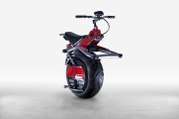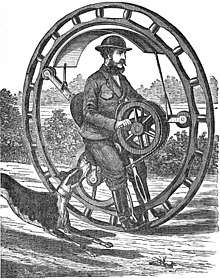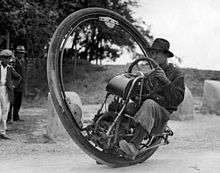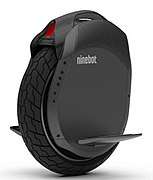Electric unicycle

An electric unicycle is a self-balancing personal transporter with a single wheel. The rider controls the speed by leaning forwards or backwards, and steers by twisting the unit using their feet. The self-balancing mechanism uses gyroscopes, accelerometers in a similar way to that used by the Segway PT.
- Theory of operation
Most commercial units are self-balancing in the direction of travel only (single axis) with lateral stability being provided by the rider; more complex fully self-balancing dual-axis devices also need to self-balance from side to side. The control mechanisms of both use control moment gyroscopes, reaction wheels and/or auxiliary pendulums and can be considered to be inverted pendulum.
History

Early experimentation
- See also Monowheel
A hand-power monowheel was patented in 1869 by Richard C. Hemming[1] with a pedal-power unit patented in 1885.[2] Various motorized monowheels were developed and demonstrated during the 1930s without commercial success[3] and Charles F Taylor was granted a patent for a 'vehicle having a single supporting and driving wheel' in 1964 after some 25 years of experimentation.[4]
Commercialisation
In 2003, Bombardier announced a conceptual design for such a device used as a sport vehicle, the Embrio.[5] In September 2004 Trevor Blackwell demonstrated a functional self-balancing unicycle, using the control-mechanism similar to that used by the Segway PT and published the designs as the Eunicycle.[6] In November 2006 Janick and Marc Simeray filed a US patent for a compact seatless device,[7]. In 2008 RYNO Motors demonstrated their prototype unit.[8] In January 2009 Focus Designs demonstrates electric unicycle to Segway inventor.[9] In Oct 2010 Focus Designs published a video of an electric unicycle with hub motor and a seat.[10]
Shane Chen of Inventist launched the compact seatless 'Solowheel' in February 2011[11] and in the following month concluded a licensing agreement with the Simeray brothers[12][13] and filed a patent relating to the device[14] which was challenged by the Simeray brothers in a related patent application filed in 2015.[13]
Late in 2015, the Ford Motor Company patented a "self-propelled unicycle engagable with vehicle", intended for last-mile commuters.[15]
In April 2018 Ryno Motors, publishes video about invention of single wheel motorcycle.[16]
Popular culture
- A self-balancing unicycle was described in 1969 in The Man From R.O.B.O.T., a short story by science fiction author Harry Harrison.[17]
- Fenton Crackshell, a Disney character, is depicted wearing a robotic unicycle suit as Gizmoduck.
- Demolishor, a Decepticon from the 2009 Transformers sequel, whose robot mode is a gigantic robotic unicycle.
- The "tumblebugs" in The Roads Must Roll
- The protagonist in the Flash browser game, Little Wheel.[18]
- In The Lorax, protagonist Ted Wiggins uses a self-balancing unicycle with handlebars.
- Thor, fictional inventor of the wheel and the comb, of the comic strip B.C..
- Securitrons from Fallout: New Vegas.
Gallery







See also
- Regulation of personal transporters
- Self-balancing scooter (with two parallel wheels)
- Ballbot, a dynamically-stable mobile robot designed to balance on a single spherical wheel
- Honda U3-X, which looks like a self-balancing unicycle, but balances on a powered Omni wheel
- Inertia wheel pendulum
- Onewheel, a sort of electric skateboard with one wheel
- RIOT wheel, a ridable single-axis self-balancing unicycle with an unusually low centre of gravity, with its rider in front of, rather than on top of its single wheel
- Uno, a self-balancing dicycle
References
- ↑ Improvement in velocipede, 1869
- ↑ US Patent 325,548
- ↑ "One-wheeled motorcycles: As cool as they are wildly dangerous". Wired. 24 March 2014.
- ↑ US Patent 3,145,797
- ↑ "Hot Wheel". Forbes.
- ↑ "Journal entry for 25 September 2004". Live Journal. 25 September 2004.
- ↑ US patent 6,616,313 Motorized transport vehicle for a pedestrian
- ↑ "A brief history of the RYNO". RYNO.
- ↑ "SBU meet the Segway | Self-Balancing Unicycle | Focus Designs, Inc". focusdesigns.com. Retrieved 2018-10-07.
- ↑ focusdesigns (2010-10-11), Self Balancing Unicycle (SBU) V2.0, retrieved 2018-10-07
- ↑ "Solowheel self-balancing unicycle is as easy to ride as it is to afford". Wngadget. 2011-02-11.
- ↑ "Patent and technology licence agreement" (PDF).
- 1 2 "Longitudinally and laterally self-balanced electric unicycle".
Inventist and its owner Shane Chen concluded with the present applicant Simeray in March 2011 a license of Simeray's 2005 invention... During the negotiation of the license, and without disclosing it to Simeray, Shane Chen has filed the utility patent application US 20110220427
- ↑ US Patent 8,807,250 Powered single-wheeled self-balancing vehicle for standing user
- ↑ Read, Richard (December 29, 2015). "Ford Patent Could Transform Your Car Into A Unicycle". The Car Connection. Internet Brns Automotive Group. Retrieved 10 September 2016.
- ↑ RYNO Motors (2018-04-20), RYNO Motors at the Cutting Edge of Innovation, retrieved 2018-10-06
- ↑ ANALOG — Science Fiction/Science Fact, Vol. LXXXIII, No. 5, July 1969, pp. 120-151. Illustrations by Peter Skirka.
- ↑ "Little Wheel - game at". Fastgames.com. Retrieved 2013-04-26.
- ↑ "SBU testing has begun… | Self-Balancing Unicycle | Focus Designs, Inc". focusdesigns.com. Retrieved 2018-10-07.
Further reading
- Research papers (in reverse date order)
- Wu, Junfeng; Zhang, Wanying; Wang, Shengda (26 November 2012). "A Two-Wheeled Self-Balancing Robot with the Fuzzy PD Control Method". Mathematical Problems in Engineering. 2012: 1–13. doi:10.1155/2012/469491.
- Tomašić, Tomislav; Demetlika, Andrea; Crneković, Mladen (2012). "Self-balancing mobile robot tilter". 36 (3). Transactions of FAMENA: 23.
- Ruan, Jian-Wei Zhao; Xiao-Gang (1 September 2011). "Modelling and Control of a Flexible Two-Wheeled Self-Balancing Mobile Robot". International Journal of Systems, Control and Communications. 3 (3): 330–355. doi:10.1504/IJSCC.2011.042438 – via ACM Digital Library.
- Ben S. Cazzolato, David Keith Caldecott, Andrew John Edwards, Matthew Anthony Haynes, Miroslav Jerbic, Andrew Christopher Kadis and Rhys James J. Madigan Micycle - A Self-Balancing Unicycle, University of Adelaide, 2010
- Johnson, R.C. (2002). "Unicycles and bifurcations" (PDF). American Journal of Physics. 66 (7): 589–92. doi:10.1119/1.19027.
- Zenkov, DV, AM Bloch, and JE Marsden (2001). "The Lyapunov-Malkin Theorem and Stabilization of the Unicycle with Rider". Systems and Control Letters. 45 (4): 293–302. doi:10.1016/s0167-6911(01)00187-6.
- Zenkov, DV, AM Bloch, NE Leonard and JE Marsden (2000). "Matching and Stabilization of Low-dimensional Nonholonomic Systems" (PDF). Proc. CDC. 39: 1289–1295. Archived from the original (PDF) on 2003-06-27.
- S. V. Ulyanov et al. (1998). "Soft computing for the intelligent robust control of a robotic unicycle with a new physical measure for mechanical controllability". Soft Computing. 2 (2): 73–88. doi:10.1007/s005000050036.
- Sheng, Zaiquan; Yamafuji, Kazuo (1995). "Realization of a Human Riding a Unicycle by a Robot". Proceedings of the 1995 IEEE International Conference on Robotics and Automation. 2: 1319–1326. doi:10.1109/ROBOT.1995.526027.
- A. Schoonwinkel, Design and test of a computer stabilized unicycle Ph.D. dissertation, Stanford University, California, 1987
| Wikimedia Commons has media related to Self-balancing unicycles. |
- Other
- Flexible two-wheeled self-balancing mobile robot, 9th IFAC Symposium on Robot Control (2009)
- Balancing on one wheel scooter Hackaday (March 2007)
- MF2006: The electric unicycle April 2006
- Photo of Trevor Blackwell's electric Self-balancing Unicycle (April 2006)
- Build Your Own Self-Balancing Unicycle (January 2005)
- Reference to Trevor Blackwell's electric Self-balancing Unicycle (September 2004)
- Legality crowdsourcing forum electric unicycling (detailed legal information for a number of countries)
- Electric Unicycle Forum (International forum on electric unicycles)